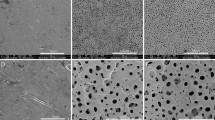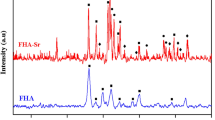Abstract
The purpose of this work was to investigate the influence of acid treatment on the surface properties and in vivo performance of titanium grade 5 (Ti6Al4V) alloy. Mini-implants with surface treatment were inserted into New Zealand rabbit tibia for 1, 4 and 8 weeks. SEM analysis showed intercommunicated micropores in acid treated samples. AFM showed micron and sub-micron roughness. The thickness of the titanium oxide layer increased with surface treatment, with a significant reduction of Al and V concentration. Acid treated implant removal torque was larger than without treatment. The implants/bone interface of acid treated implants showed dense adhered Ca/P particles with spreading osteoblasts after 4 weeks and newly formed bone trabeculae after 8 weeks. Analysis of rabbit blood that received treated implant showed lower Al and V contents at all times. Acid treatment improved surface morphology and mechanical stability, which allowed initial events of osseointegration, while Al-V ion release was reduced.
Graphical abtsract








Similar content being viewed by others
References
Truong VK, Lapovok R, Estrin YS, Rundell S, Wang JY, Fluke CJ, Crawford RJ, Ivanova ER. The influence of nano-scale surface roughness on bacterial adhesion to ultrafine-grained titanium. Biomaterials. 2010;31:3674–83.
Estrin Y, Ivanova EP, Michalska A, Truong VK, Lapovok R, Boyd R. Accelerated stem cell attachment to ultrafine grained titanium. Acta Biomaterialia. 2011;7:900–6.
Geetha M, Singh AK, Asokamani R, Gogia AK, Ti based biomaterials, the ultimate choice for orthopaedic implants – a review.Progr Mater Sci. 2009;54:397–425
Niinomi M. Mechanical properties of biomedical titanium alloys. Mat Sci Eng A. 1998;243:231–6.
Long M, Rack HJ. Titanium alloys in total joint replacement – a materials science perspective. Biomaterials. 1998;19:1621–39.
Elias CN, Rocha FA, Nascimento AL, Coelho PG. Influence of implant shape, surface morphology, surgical technique and bone quality on the primary stability of dental implants.J Mech Beh Biomed Mater. 2012;16:169–80
Schmuki P. From Bacon to barriers: a review on the passivity of metals and alloys. J Solid State Electr. 2002;6:145–64.
Elias CN. Factors affecting the success of dental implants. In: Turkyilmaz I, editor Implant Dentistry - A Rapidly Evolving Practice. New York, NY: InTech; 2011. p. 319–64.
Elias CN, Meirelles L. Improving osseointegration of dental implants. Expert Rev Med Devices. 2010;7:241–56.
Wong M, Eulenberger J, Schenk R, Hunziker E. Effect of surface-topology on the osseointegration of implant materials in trabecular bone. J Biomed Mater Res. 1995;29:1567–75.
Massaro C, Rotolo P, De Riccardis F, Milella E, Napoli A, Wieland M. Comparative investigation of the surface properties of commercial titanium dental implants. Part I: chemical composition. J Mater Sci Mater Med. 2002;13:535–48.
Zinger O, Anselme K, Denzer A, Habersetzer P, Wieland M, Jeanfils J. Time-dependent morphology and adhesion of osteoblastic cells on titanium model surfaces featuring scale-resolved topography. Biomaterials. 2004;25:2695–711.
Gittens RA, Olivares-Navarrete R, McLachlan T, Cai Y, Hyzy SL, Schneider JM, Schwartz Z, Sandhage KH, Boyan BD. Differential responses of osteoblast lineage cells to nanotopographically-modified, microroughened titanium-aluminum-vanadium alloy surfaces. Biomaterials. 2012;33:8986–94.
Chambers TJ, Revell PA, Fuller K, Athanasou NA. Resorption of bone by isolated rabbit osteoclasts. J Cell Sci. 1984;66:383–99.
Davies JE, Ajami E, Moineddin R, Mendes VC. The roles of different scale ranges of surface implant topography on the stability of the bone/implant interface. Biomaterials. 2013;34:3535–46.
Cameron HU, Pilliar RM, Macnab I. The rate of bone ingrowth into porous metal. J Biomed Mater Res. 1976;10:295–302.
Skedros JG, Holmes JL, Vajda EG, Bloebaum RD. Cement lines of secondary osteons in human bone are not mineral deficient: new data in a historical perspective. Anat Rec A. 2005;286:781–803.
Zhao C, Ji W, Han P, Zhang J, Jiang Y, Zhang X. In vitro and in vivo mineralization and osseointegration of nanostructured Ti6Al4V. J Nanopart Res. 2011;13:645–54.
Mas-Moruno C, Dorfner PM, Manzenrieder F, Neubauer S, Reuning U, Burgkart R, Kessler H. Behavior of primary human osteoblasts on trimmed and sandblasted Ti6Al4V surfaces functionalized with integrin alpha v beta 3-selective cyclic RGD peptides. J Biomed Mater Res A. 2013;10:87–97.
Mendes VC, Moineddin R, Davies JE. The effect of discrete calcium phosphate nanocrystals on bone-bonding to titanium surfaces. Biomaterials. 2007;28:4748–55.
Deguchi T, Takano-Yamamoto T, Kanomi R, Hartsfield JK Jr, Roberts WE, Garetto LP. The use of small titanium mini-implants for orthodontic anchorage. J Dent Res. 2003;82:377–81.
Morais LS, Serra GG, Muller CA, Andrade LR, Palermo EFA, Elias CN, Meyers M. Titanium alloy mini-implants for orthodontic anchorage: Immediate loading and metal ion release. Acta Biomat. 2007;3:331–9.
Moon S-H, Lee S-J, Park I-S, Lee MH, Soh YJ, Bae T-S, Kim H-S. Bioactivity of Ti-6Al-4V alloy implants treated with ibandronate after the formation of the nanotube TiO2 layer. J Biomed Mater Res B. 2012;100:2053–9.
Callen BW, Lowenberg BF, Lugowski S, Sodhi RN, Davies JE. Nitric acid passivation of Ti6Al4V reduces thickness of surface oxide layer and increases trace element release. J Biomed Mater Res. 1995;29:279–90.
Ask M, Lausmaa J, Kasemo B. Preparation and surface spectroscopic characterization of oxide films on Ti6A14V. Appl Surf Sci. 1988;35:283–9.
Feng B, Chen JY, Qi SK, He L, Zhao JZ, Zhang XD. Characterization of surface oxide films on titanium and bioactivity. J Mater Sci Mater Med. 2002;13:457–64.
Uuban RM, Jacobs JJ, Tomilson MJ, Gavrilovic J, Black J, Peoch M. Dissemination of wear particles to the liver, spleen, and abdominal lymph nodes of patients with hip or knee replacement. J Bone Joint Surg. 2000;82:457–77.
de Morais LS, Serra GC, Palermo EFA, Andrade LR, Muller CA, Meyers MA, Elias CN. Systemic levels of metallic ions released form orthodontic mini-implants. Am J Orthod Dentofac Orthop. 2009;135:522–9.
Heinemann G, Fichtl B, Vogt W. Pharmacokinetics of vanadium in human after intravenous administration of a vanadium containing albumin solution. Br J Clin Pharmacol. 2003;55:241–5.
Liu P, Yao YN, Wu SD, Dong HJ, Feng GC, Yuan XY. The efficacy of deferiprone on tissues aluminum removal and copper, zinc, manganese level in rabbits. J Inorg Biochem. 2005;99:1733–7.
Kuromoto NK, Simao RA, Soares GA. Titanium oxide films produced on commercially pure titanium by anodic oxidation with different voltages. Mater Charac. 2007;58:114–21.
Maitz MF, Pham MT, Wieser E, Tsyganov I. Blood compatibility of titanium oxides with various crystal structure and element doping. J Biomater Appl. 2003;17:303–19.
Shao H, Yu C, Xu X, Wang J, Zhai R, Wang X. Influence of Ti nanocrystallization on microstructure, interface bonding, surface energy and blood compatibility of surface TiO2 films. Appl Surf Sci. 2010;257:1649–54.
Marmur A. Soft contact: measurement and interpretation of contact angles. Soft Matter. 2006;2:12–7.
Tuteja A, Choi W, Ma M, Mabry JM, Mazzella SA, Rutledge GC, McKinley GH, Cohen RE. Designing superoleophobic surfaces. Science. 2007;318:1618–22.
Forsgren J, Paz MD, Leon B, Engqvist H. Laser induced surface structuring and ion conversion in the surface oxide of titanium: possible implications for the wetability of laser treated implants. J Mater Sci Mater Med. 2013;24:11–5.
Acknowledgements
We thank Carlos Eduardo Caetano and Domingos Peçanha (Laboratory of Experimental Surgery) for the surgical support and animal care during the experimental period; Prof Marc A. Meyers (University of California) for support on the preparation of histological displays, Prof Raphael Hirata (Microbiology Laboratory- Universidade do Estado do Rio de Janeiro) for help with the blood sample preparations for atomic absorption spectrometry; and Prof Ronaldo de Biase for the revision of the manuscript. This research was supported by the grants E-26/102.766/2012, BEX 539012-5/2013, Universal 476757/2012-6, E-26/201.759/2015, E-26/201.828/2015, E-26/010.001.262/2015 and 449472-2014-0.
Author information
Authors and Affiliations
Corresponding author
Ethics declarations
Conflict of interest
The authors declare that they have no competing interests.
Rights and permissions
About this article
Cite this article
Fernandes, D.J., Marques, R.G. & Elias, C.N. Influence of acid treatment on surface properties and in vivo performance of Ti6Al4V alloy for biomedical applications. J Mater Sci: Mater Med 28, 164 (2017). https://doi.org/10.1007/s10856-017-5977-5
Received:
Accepted:
Published:
DOI: https://doi.org/10.1007/s10856-017-5977-5




